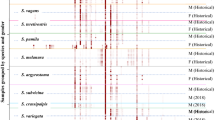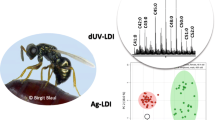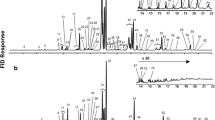Summary
We investigated cuticular hydrocarbons and fatty acids of workers and queens from two ant species, Leptothorax acervorum and L. gredleri. Cuticular compounds were extracted from single ants by solvent extraction, solid sampling, and solid phase microextraction (SPME) with two different polydimethylsiloxane (PDMS) fibers and analyzed using GC and GC-MS. All three methods gave similar results, documenting that SPME can be applied to very small, live ants (body size appr. 3 mm). The hydrocarbon mixtures consisted mostly of branched and unbranched alkanes and alkenes within the range of C25 to C33. Dufour glands of both species contained a blend of hydrocarbons different from those found on the cuticle. In addition, terpenoids, especially tetramorenes were present in the Dufour gland contents. In a principal components analysis based on the relative proportions of cuticular compounds, most nestmate workers clustered in four groups corresponding to the original four investigated colonies. Queens and workers differed significantly in their chemical profiles, suggesting that the two castes bear specific labels.
Similar content being viewed by others
Author information
Authors and Affiliations
Additional information
Received 19 December 2000; accepted 3 August 2001.
Rights and permissions
About this article
Cite this article
Tentschert, J., Bestmann, H. & Heinze, J. Cuticular compounds of workers and queens in two Leptothorax ant species — a comparison of results obtained by solvent extraction, solid sampling, and SPME. Chemoecology 12, 15–21 (2002). https://doi.org/10.1007/s00049-002-8322-4
Published:
Issue Date:
DOI: https://doi.org/10.1007/s00049-002-8322-4




